Grand Tour of South America –with World Journeys

By Mandy Brown
In September this year (2018) my husband and I joined World Journeys on their Small Group Hosted Grand Tour of South America. World Journeys return to South America every year, having put together a fantastic itinerary, incorporating the treasures of this amazing continent. We journeyed through 6 countries in 33 days with an incredible host taking care of everything.
Our first sight of Chile was from a few thousand metres in the sky on-board our Latam Dreamliner. We flew into Santiago on a beautiful day with a spectacular view of the snow topped Andes. Our small hosted group of 10, including our host Julie arrived in Santiago ready for some great adventures and amazing experiences.
Santiago, Chile

We got straight into touring the city of Santiago as we were not going to be here for long. Firstly we walked to the Presidential Palace and viewed the changing of the guard. Santiago is a city of 7 million people, set in a deep valley surrounded by mountains, no wind, no rain, which unfortunately means there’s an unwanted layer in the air of this cosmopolitan city. The Andes that surround the city are breathtaking and the panoramic view from the Cerro San Cristobal hill is a must to do, that also helps to get your bearings. You can get there by car, hiking, the funicular or the cable car to the top. At the end of the day we had a couple of big flights ahead of us as we were heading to Quito the capital of Ecuador.

Quito, Ecuador

Quito is situated 2,850 metres above sea level, so we took it slowly as this was our first stop where we would be staying at a very high altitude. (Just a little history:- Quito is named after its first inhabitants the Quito’s, who lived here until they were invaded by the Incas, who were themselves eventually invaded by the Spanish). Quito is situated in a narrow valley between the base of the Pichincha Volcano and the Guayllabamba river. Further out from the city along the river valley are many more volcanoes. Not only is Quito the highest capital city in the world it is also the closest to the equator. Due to its unusual combination of altitude and latitude Quito’s climate stays fairly cool, with two seasons, wet and dry. The atmosphere we experienced was very dry, which made us very thirsty on top of the high-altitude thirst. We spent the first day touring the old city.
On our second day myself and two other group members left Quito and headed out on day tour to Otavalo. Our first stop was on the outskirts of the city at a small shop where the family made small bread figurines of people who have died and other traditional figures for families to purchase for funerals and for the ritual held the first two days of November “The day of the dead”. They take the figurines for their dead loved ones and have a meal in honour them while sitting on their grave. A bit macabre, but the figurines were brightly coloured and the way they talked about it seemed a lot of family fun! We then headed further north on the Pan-American highway to go to the famous Artisan markets of Otavalo. We stopped on our way for photos as we crossed the equator, standing between two statues of men bowing from either hemisphere.
We also stopped at a small town where every second shop sold a very special biscuit called Bizchocos. We were taken for a tour through the kitchen of one of the bakeries, which was a room with two wood burning ovens, trays and trays of golden biscuits and a woman sitting in front of the biggest lump of dough I’ve ever seen. She hand rolls and cuts over 3000 of these biscuits a day, working the dough and cutting with speed. We were given some to eat and they were very crisp and buttery, not sweet, but they last for a couple of weeks. Originally made for long journeys in the past when getting across the country required long treks over the Andes and around the many volcanoes that exist. We carried on north stopping at a small restaurant with an amazing view of a lake and yet another volcano. The restaurant also had local food artisans offering their products to try. There was local honey, sweet cheese Camembert, fig jelly and wild blackberry jam. Also, a young boy with two Alpacas with attitude.
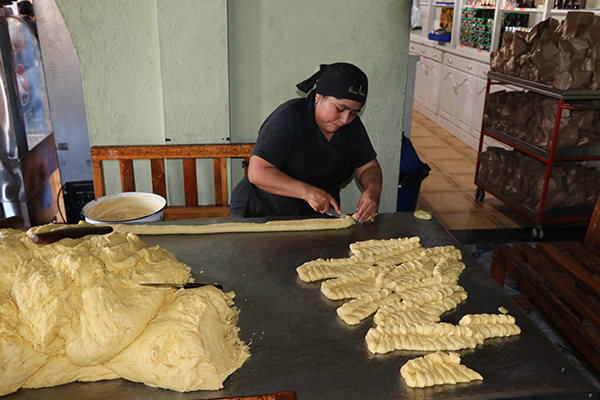
We finally arrived at the Otavalo markets, where the three of us bought the best quality, locally made Panama Hats, as Ecuador is where they originate from. The market was full of colour and people selling all sorts of things made our of Alpaca wool. It was great having Bonny, our guide with us as she was able to help barter and point to products she said were not made in Ecuador (there were a few, so be careful).
After our market shopping we visited two families one musical and one a weaving family who showed their products and how they are made and played. It was a very big day after stopping for a late lunch at a restaurant situated on a lakeside by more volcanoes.

Ecuadorian - Amazon Rainforest

We left Quito and flew to Coca, which is across the Andes to the west. A small village that is situated in the Ecuadorian Rainforest. We arrived at Sacha Lodge after departing Coca on a 2-hour canoe ride then a 1 km walk through the jungle, followed by another canoe ride through the along small creek like river in the jungle, across a blackwater lake called Pilichicocha to our home for 3 days of exploration. It was a privilege to see some incredible wildlife and fauna with the best and most knowledgeable local guides. There were lots of guided walks through the rainforest and up into the treetops, both day and night. I’d recommend staying here for the most amazing experience.

We saw many birds, monkeys, a sloth, spiders, insects, snakes, including a Boa. One of my highlights was Piranha fishing on the blackwater lake. I caught one, but in my nervousness reaching to hold it for the photo I dropped it on my leg, then screamed and jumped in the canoe which made the Piranha jump and fall back into the lake. Quite an experience. The Amazon Rainforest is an incredible place to visit, although we didn’t see any major deforested areas there were areas that had been carved away for the oil fields. Quite an unusual sight was seeing oil tankers on barges cruising up and down the river. Sacha Lodge was a wonderful experience.
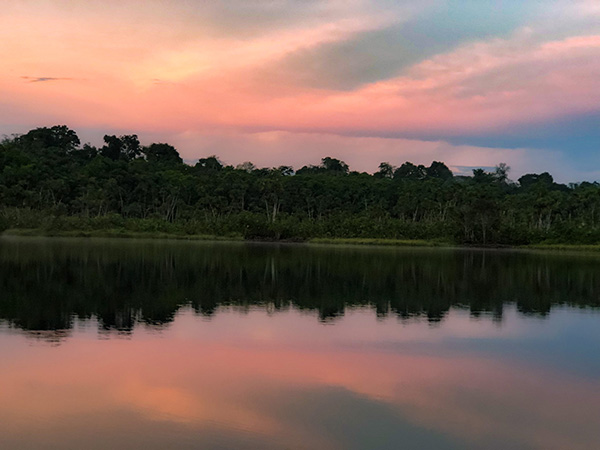
Video of Sacha Lodge below
The Galapagos, Ecuador
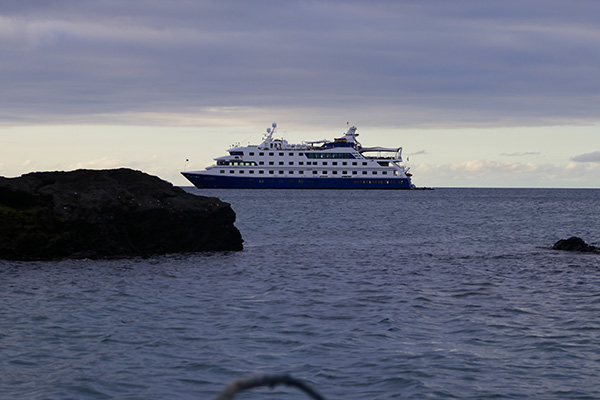
We flew back over the Andes and into Quito again to get to our flight out to the next big adventure that we were all very excited about, The Galapagos. After arriving in the Galapagos, we boarded our cruise boat Santa Cruz II ready for 5 days of exploring this incredible cluster of islands.
Day one in the Galapagos and we took a zodiac across to one of the islands and there on the beach was a Marine Iguana, one of the Top 15 species that we are hoping to see. Out of the 'Big 15' we managed to see 11. The iguanas were much smaller that I expected and there were lots of them. They seemed to be everywhere. The guides and staff on Santa Cruz II were exceptional, from the moment we arrived on the ship they had us organized. We were put into guided groups, also fitted out with snorkeling gear, settled in our rooms, dined on fabulous food, taken out in the zodiacs for a beach walk and wildlife walk with our guides. They got us all swimming with our snorkeling gear from the beach to ensure that there weren’t any gear problems. We were then back to the boat for drinks and a briefing for the following day, before an a la cart dinner in the evening. The organization was amazing, there was absolutely no reason for anyone to say they were bored, we were busy every minute of the day.

Our guide, Sebastian was a local Galapagonian lad who was a fantastic fun guide. He’d have us in our Panga (Zodiac) cruising around the coastline wildlife watching. We found Blue Footed Boobys, Swallow tailed Gulls, the Galapagos Turn, Fur Seals and many other birds. We loved the Boobys who were very inquisitive, and their feet are so blue!

Each day we visited a different island and saw many more Marine Iguanas, Green Turtles, Sea Lions, even one so newly born it was still attached to its umbilical cord. We had a wonderful walk around the coast and snorkeled with the Turtles and Sea Lions and Penguins. The wildlife is abundant. The different species and sub species of birds are incredible. We saw smaller Marine Iguanas, Red Footed Boobys, the Galapagos Owl, which we watched in action catching smaller birds to eat. We saw baby Great Frigate Birds with their Mother’s and so many more. We snorkeled in large schools of fish and we mastered the Galapagos species naming. The Santa Cruz II team were fantastic, and I’d recommend cruising with them. Before we departed the Galapagos, we visited a small sanctuary to see the Giant Galapagos Turtle. Again, I thought we’d see a couple or a few, but we saw so many I lost count, they were everywhere.

Lima, Peru

We left the Galapagos and flew to Lima, the capital of Peru, spending one day getting to know a bit about the city, the Incas and the ancient Peruvians. We met a lovely Peruvian woman and her 3-month-old boy in the older part of the city. She was selling Coca leaves and sweets for those preparing to head up into the higher altitudes. We visited the San Isidro district and visited the pre Inca adobe platform of the Huaca Huallamarca. We wandered around the colonial part of the city and then visited the Larco Herrera Museum, which houses the finest examples of Inca and pre-Inca artefacts in the world. They included magnificent artefacts, jewelry, vases, masks, tools and erotic pottery, also ancient textiles all preserved in the arid climate of the Peruvian desert coast. We finished with a wonderful lunch at the Museum garden café. My husband and I went out in the evening and enjoyed a Peruvian meal at Sagra in Miraflores, which was a couple of blocks walk from our hotel and set in an old colonial building. The chef clearly specialised in desserts, they were incredible. All the food was wonderful as well, but if you get there save some space for dessert.

Sacred Inca Valley, Peru

We left Lima and flew to Cuzco, heading straight from the high altitude of the city to spend some time in the Sacred Valley of the Incas, acclimatising. Our accommodation was in an old converted Monastery in Yukay, set in beautiful gardens. On our journey from Cusco we made a short stop at Awanakancha, where we saw Llamas, Alpacas and Vicunas together, and there is a slight difference with each one. We then drove on and stopped to visit the Andean village of Pisac, best known for its Sunday market in the main square.

On our second day in the valley we walked around the impressive circular agricultural terraces at Moray, which were built by the Incas in natural sink holes. We went on and visited the ancient salt mines that date back to the pre-Incas and are still in use today in Maras. In the afternoon we visited the temple ruins in Ollantaytumbo, this is one of the most monumental, architectural complexes of the ancient Inca Empire. It is also the best surviving example of Inca city planning, with narrow cobblestone streets that have been continuously inhabited since the 13th century.

Machu Picchu, Peru
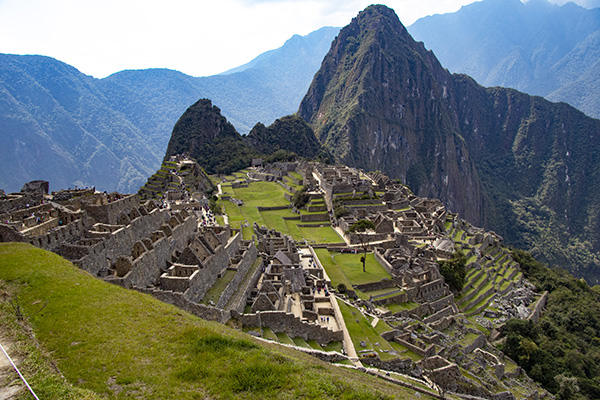
We then left by train from Ollantaytumbo and headed to Aguas Calientes which is at the foot of the mountain and the ancient city of Machu Picchu. During our travels In Peru, Ecuador, Chile and Bolivia we had the sight of the magnificent Andes, on the train we were so close we had large glaciers looming above us.
Once we arrived we headed by bus up the long and very winding road to the ancient city entrance. We had tickets to visit in the afternoon from midday until 5.30pm. Due to the huge number of visitors they have split visits into morning and afternoon. We walked through the main gate and into an ancient world. Machu Picchu needs no words, it is the most incredible place in the world.

After a train trip out of the Scared Valley we headed to Cuzco, stopping on the way in a small village high on the lower hills called Chincheros. This village is one of the most important weaving centres in all Latin America. We were entertained by a young Inca girl who showed us how to dye the Alpaca wool the Inca way, after sacrificing a few cochineal bugs!

Cuzco, Peru
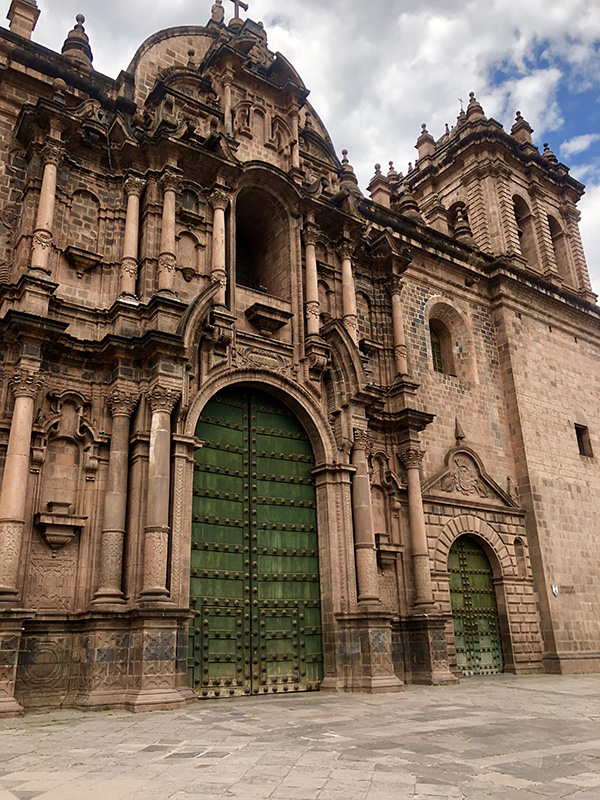
Cuzco is the ancient capital of the Incan Empire and is UNESCO listed. Throughout the city you have remains of Incan buildings that were used as the bases of the Colonial buildings. It is a bright, bustling city full of tourists and many backpackers. Cuzco's restaurants and cafes were varied and included lovely fusion European, Asian and Indian with Peruvian dishes. My husband and I were recommended a restaurant called Limo, which was Asian/Peruvian fusion and it was amazing, I highly recommend it.

A short drive out of the city stands the massive walls of Sacsayhuaman Fortress and further on more incredible Incan sites. The Cathedral, which is built in the form of an ancient cross is very impressive, with the silver covered altar and a painting of the Last Supper where guinea pig is served (this is a traditional food of the region).
Luxury Train ride from Cuzco to Puno, Peru

We left Cuzco by train and headed to Puno on the shore of Lake Titicaca. This was a 10-hour trip onboard a luxury train, the Andean Explorer. The décor in the train looked a bit like the Orient Express. We were served snacks, drinks and a 3 coursed meal on-board. The staff were wonderful and were also part of the entertainment on-board, which included dancing and a fashion parade.
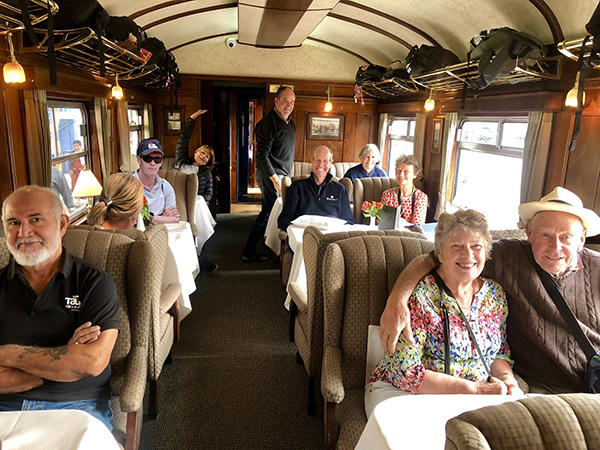
Puno was only a sleep stop and the next morning we were driven to the border between Peru and Bolivia on the edge of the lake. We went into an office and departed from Peru, walked 100 metres up the road into another office and checked in to Bolivia.
Lake Titicaca, Bolivia

We spent a couple of days cruising around Lake Titicaca on the Bolivian side. We visited Sun Island, but my highlight was meeting the wonderful people who live on the edge of the lake and use the reeds for all manner of things, from cheese molds to boats. We also sailed onboard one of their magnificent reed boats. We were shown through their own museum, which although rough contains many ancient artefacts. In the evening a group of local teenagers came on board to sing and dance their traditional dances. And still we could see
the magnificent Andes.

La Paz, Bolivia
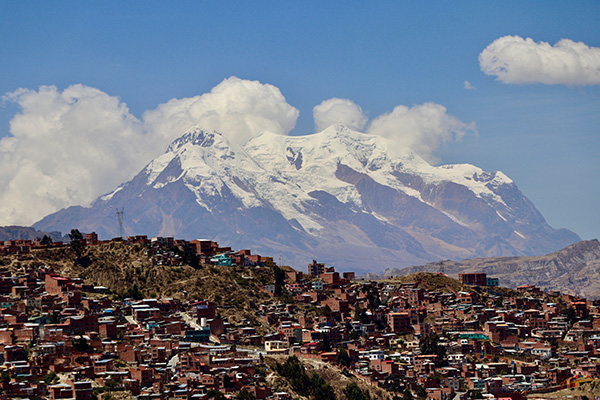
We left Lake Titicaca drove to La Paz, passing through El Alto, the youngest and fastest growing city in the western hemisphere. La Paz is the highest city in the world and varies between 3,000 to 4,100 metres above sea level. The city is situated in a bowl surrounded by the high altiplano and close to the Andes.
La Paz is a very busy city, with just about every vehicle being a taxi or bus. The many steep streets and alleys sometimes became difficult to walk with the reduced oxygen of the altitude, hence the many forms of transport. The most recent public transport was a system of 9 (to be 11) cable cars that traversed the city. The views from the cable cars were impressive.

I found the old Witches Market very interesting to wander through, although some of the things for sale were a bit macabre. The Valley of the Moon was incredible. This amazing lunar landscape is comprised of eroded miniature canyons and pinnacles of clay, ever changing when it rains. We also had a wonderful visit to the home of internationally renowned ceramic artist, Senor Mario Sarabia. His art is shaped by his India/part Spanish heritage. The pieces were all beautiful. His daughters are also artists, one a ceramic artist like her father and the other a jeweler. La Paz would have to be one of our favourite cities at this point.

Rio de Janeiro, Brazil

We left the western coast of South America and flew to Rio de Janeiro, Brazil, our hotel overlooked Copacabana beach. What I had in my head about Rio and what it would look like is nothing like it was. It felt to me like we were in a very large Waikiki. At no stage did we feel uncomfortable or unsafe, although we were warned to be vigilant with our belongings and cautious about where we went.
We took a ride on the cog train up Corcovado hill to visit ‘Christ the Redeemer’. Here we had the most spectacular view of the whole city where you can get the best perspective of the landscape.

We then visited H Sterns a jewelry company in Brazil, where we were taken through the process of cutting Brazils precious stones right to the finished piece. Over 65 percent of the worlds precious stones come from Brazil. Trying on some of the most amazing jewelry was a highlight for some of us
As we were in Ipanema we stopped at the Bar where two friends composed “The girl from Ipanema”, inspired by a local girl that they’d admired when she was out walking. The actual girl still lives very near the bar. She is now in her late 70’s.
Rio de Janeiro, Brazil is an amazing place and has quickly become one of our favourite cities. There is so much to see and do. We’d love to come back around Easter when Carnival in on, which sounds like an incredibly fun time, especially if you manage to get in early and get the best seats in the Sambadrome.
A must for all tourists is a ride up the cable car to the top of Sugarloaf Mountain, where we enjoyed the view of Rio and met the tiny monkeys who live up there. Some of us took a quick helicopter ride from half way up the mountain, flying along Copacabana and Ipanema beaches and back again (a massive highlight and smile maker)

The Metropolitan Cathedral is an enquired taste, but amazing inside, along with the patron Saint Sebastián art piece.

Iguazu National Park, Brazil & Argentina

We flew out of Rio and headed south near the Argentinean border to Iguazu National Park. Once we arrived in the park we visited a bird sanctuary that was extremely impressive and colourful. Unfortunately, the local monkeys are cunning and quickly got one on me by jumping from a fence towards me grabbing my freshly bought lunch and jumping away with it. A few of us took a helicopter flight over the Iguazu Falls. This was a spectacular introduction to this incredible sight. The falls are situated on the borders of Brazil, Argentina and Paraguay. We walked the tracks that meander along the Brazilian side of the falls and river in the afternoon, before heading to our accommodation just on the edge of the rainforest.

The next day we passed through the border to the Argentinean side of the park and spent the day at the falls. The 8 km’s of pathways around the falls gave us stunning and close views, very close in fact we got quite wet. Everyone was in awe of the spectacular sight. After lunch 4 of us decided to get even closer and were taken further into the Rainforest and down to the water’s edge for an incredible jetboat ride up the river to the falls and so close to a couple of them you almost felt like you were totally submerged. An amazing experience. The Iguazu Falls were more impressive than I thought they’d be.
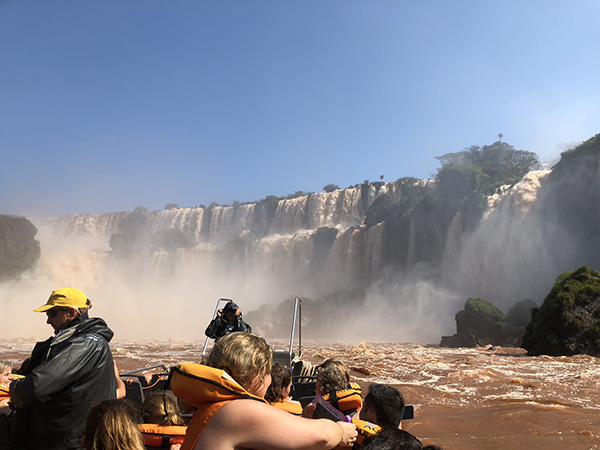
Buenos Aires, Argentina

When we departed from Iguazu we all had that feeling that the journey was coming to an end. Buenos Aires was our last stop of the Grand Tour of South America. It is a city of bright colours, a vast mixture of classic and new architecture. We toured the city and viewed the many different neighbourhoods. Visiting the Recoleta Cemetery, the final resting place of Eva Peron, was like taking a tour through a small neighbourhood.

Our visit to the neighbourhood of San Telmo was a visual display of brightly coloured buildings and young couples in costume dancing the Tango. As for the meals in Argentina, we quickly learnt that the one meal is easily shared by two. We were also introduced to the tea drink in Argentina called Verba Mate. It contains large amounts of caffeine, with the leaves steeped in a special cup and drunk through a metal straw shaped like a spoon that is used to filter the leaves.

Our journey was busy with 16 flights and 15 different beds, but we covered so much in really a short amount of time, enjoying every moment. We visited truly incredible destinations and saw the most amazing animals, geography, buildings and cultures. This was the first time we had experienced a small group hosted tour, but World Journeys have successfully packaged a great journey with a fantastic host.




